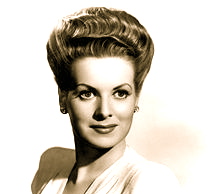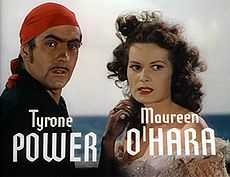Maureen O’Hara


Early life and career
Maureen O’Hara (born 17 August 1920) is an Irish film actress and singer. The famously red-headed O’Hara has been noted for playing fiercely passionate heroines with a highly sensible attitude. She often worked with director John Ford and longtime friend John Wayne. Her autobiography, ‘Tis Herself, was published in 2004 and was a New York Times Bestseller.
O’Hara was born as Maureen FitzSimons on Beechwood Avenue in the Dublin suburb of Ranelagh. She was the second oldest of the six children of Charles Stewart Parnell FitzSimons and Marguerita Lilburn FitzSimons. Her father was in the clothing business and also bought into Shamrock Rovers Football Club, a team O’Hara has supported since childhood. Her mother, a former operatic contralto, was a successful women’s clothier. O’Hara was raised as, and still is, a Roman Catholic. Her siblings were Peggy, the oldest, and younger Charles, Florrie, Margot and Jimmy. Peggy dedicated her life to a religious order, the Sisters of Charity, and the younger children all went on to receive training at the Abbey Theatre and the Ena Mary Burke School of Drama and Elocution in Dublin. O’Hara’s dream at this time was to be a stage actress. She was first educated at the John Street West Girls’ School near Thomas Street in Dublin’s Liberties Area. From the age of 6–17 she trained in drama, music and dance, and at the age of 10 joined theRathmines Theatre Company and worked in amateur theatre in the evenings, after her lessons.
O’Hara’s father was a very practical man and did not entirely support her theatrical aspirations. He insisted she learn a skill so that she would have something to fall back on to earn a living in case her experience in the performing arts was not successful. She enrolled in a business school and became a proficient bookkeeper and typist. Those skills proved helpful many years later when she was able to take and transcribe production notes dictated by John Ford for the screen adaptation of Maurice Walsh‘s short story The Quiet Man.
She did well in her Abbey training and was given an opportunity for a screen test in London. The studio adorned her in a “gold lamé dress with flapping sleeves like wings” and heavy make-up with an ornate hair style. Reportedly, her thoughts concerning the incident were, “If this is the movies, I want nothing to do with them!” The screen test was deemed to be far from satisfactory; however, actor Charles Laughton later saw the test and, despite the overdone makeup and costume, was intrigued, paying particular notice to her large and expressive eyes.
Laughton subsequently asked his business partner Erich Pommer to see the film clip. Pommer agreed with Laughton and O’Hara was offered an initial seven-year contract with their new company, Mayflower Pictures. Her first major film was Jamaica Inn (1939) directed by Alfred Hitchcock. Laughton was so pleased with O’Hara’s performance that he cast her in the role of Esmeralda opposite him in The Hunchback of Notre Dame (1939), which was to be filmed at RKO Studios in Hollywood that same year. After the successful completion of Hunchback, World War II began, and Laughton, realizing their studio could no longer film in London, sold O’Hara’s contract to RKO. That studio cast her in low-budget films until she was rescued by director John Ford, who cast her as Angharad in How Green Was My Valley, which won the 1941 Academy Award for Best Picture. Six years later, in 1947, she made what is perhaps her best-remembered film, starring as Doris Walker and the mother of a young Natalie Wood in 20th Century Fox‘s Miracle on 34th Street, which, despite being released in May, has become a perennial Christmas classic, with a traditional network television airing every Thanksgiving Day on NBC. The film also helped to further establish O’Hara’s career after the film garnered several awards, including an Academy Award Nomination for Best Picture.
In 1946, she became a naturalized citizen of the United States and now holds dual citizenship with the U.S. and her native Ireland.
In addition to her acting skills, O’Hara had a soprano voice and described singing as her first love. The studio heads never capitalized on her musical talent, as she was already big box office in other genres of film. However, she was able to channel her love of singing through television. In the late ’50s and early ’60s, she was a guest on musical variety shows with Perry Como, Andy Williams, Betty Grable and Tennessee Ernie Ford. In 1960, she starred on Broadway in the musical Christine which ran for 12 performances. That year she released two successful recordings, Love Letters from Maureen O’Hara and Maureen O’Hara Sings her Favorite Irish Songs.Love Letters from Maureen O’Hara has been released on CD in Japan and is now out of print; Maureen O’Hara Sings Her Favorite Irish Songs has yet to be released on CD.
 With Tyrone Power in the trailer for The Black Swan (1942)
With Tyrone Power in the trailer for The Black Swan (1942)
An icon of Hollywood’s Golden Age, at the height of her career, O’Hara was considered one of the world’s most beautiful women. She is often remembered for her on-screen chemistry with John Wayne. They made five films together between 1948 and 1972: Rio Grande, The Quiet Man, The Wings of Eagles, McLintock! and Big Jake. A clip of O’Hara’s radiant face as she waves from a gate in John Ford’s Academy Award-winningHow Green Was My Valley, remains one of the most classic images preserved on film, and is often featured as a clip in montages and promotions.
Marriage, retirement and comeback
In 1939, at the age of 19, O’Hara secretly married Englishman George H. Brown, a film producer, production assistant and occasional scriptwriter whose best known work is the first of Margaret Rutherford’s 1960s Miss Marple mysteries, Murder She Said. The marriage was annulled in 1941. Later that year, O’Hara married American film director William Houston Price (dialog director in The Hunchback of Notre Dame), but the union ended in 1953, reportedly as a result of his alcohol abuse. They had one child in 1944, a daughter named Bronwyn FitzSimons Price. Bronwyn has one son, Conor Beau FitzSimons, who was born on September 8, 1970. From 1953 until 1967 O’Hara had a relationship with Enrique Parra, a Mexican politician and banker. She wrote in her autobiography; “Enrique saved me from the darkness of an abusive marriage and brought me back into the warm light of life again. Leaving him was one of the most painful things I have ever had to do.”
She married her third husband, Charles F. Blair, Jr., on March 12, 1968. Blair was a pioneer of transatlantic aviation, a former Brigadier General of the U.S. Air Force, and a former Chief Pilot at Pan Am. A few years after her marriage to Blair, O’Hara for the most part retired from acting. Blair died in 1978 when an engine of a Grumman Goose he was flying from St. Croix to St. Thomas exploded. She was elected CEO and President of Antilles Airboats with the added distinction of being the first woman president of a scheduled airline in the U.S. Later she sold the airline with the permission of the shareholders.
O’Hara remained retired from acting until 1991, when she starred in the film Only the Lonely, playing Rose Muldoon, the domineering mother of a Chicago cop played by John Candy. In the following years, she continued to work, starring in several made-for-TV movies, including The Christmas Box, Cab for Canada and The Last Dance, the latter her last film to date, released in 2000.
Now retired, she has homes in Arizona and the Virgin Islands but lives mainly in Glengarriff, County Cork. In June 2011 she participated at the Maureen O’Hara Film Festival in Glengarriff.
O’Hara made a public appearance in Kells Co. Meath on 26 May 2012 to commemorate her father, who was born in the town.
In May 2012, O’Hara’s family contacted social workers regarding claims that O’Hara was a victim of elder abuse.


